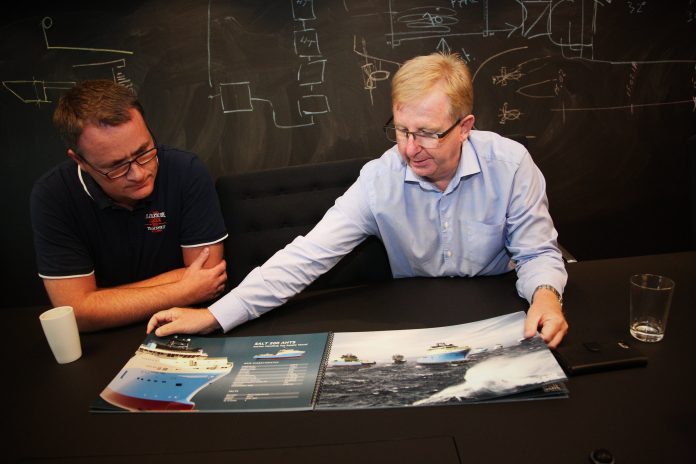“Compared to other companies, it is going quite well these days. We have a lot of work, and we have 14 boats on our order list”, CEO of Salt Ship Design, Arne Stenersen, tells SalmonBusiness.
Salt Ship Design started out on Stord, a small island in Norway, with around 12 employees in 2012. Five years later, they have 30 employees in Norway, while they also have a department in Poland with 45 employees.
From the start, the company began delivering boats designed for the offshore oil sector, and quickly signed contracts with reputable companies like Eidesvik and Østensjø. However, when the oil crisis hit Norway late 2014, they also decided to invest in the aquaculture industry.

Maersk order in 2014
Nevertheless, it was when Maersk doubled their order list for the then two-year-old company, in October 2014, by ordering six anchor handling ships, that their portfolio really took shape.
“That had a big impact,” says Stenersen.
“Our first phase was about establishing ourselves within offshore, to get a portfolio. Later, we started with fishing boats,” he adds.
New knowledge
When they entered the aquaculture sector, there was one crucial requirement: they had to revise their knowledge. They travelled around, interviewed fish farmers and surveyed their biggest operational challenges.
They sum up five key points for SalmonBusiness:
- Major problems relating to fish health, hygiene and quality.
- Too much value lost in fish mortalities.
- Inefficient cleaning, loading and unloading.
- Boats not flexible enough, as technological development makes them obsolescent.
- The need for boats with more safety features, that do not damage the cages during operations.
Now they will, together with partners, prepare future-proofed boats, which will help improve efficiency and fish welfare, with the lowest possible wastage.
“As boats become more complex, they become more expensive, and the last wellboats have been quite costly. Our job is to try to define the main roles for wellboats, and primarily aim at that”, project manager Rune Risnes tells SalmonBusiness. “Otherwise the exercise will become too expensive.”
Fish welfare
When they secured a contract for the design of two wellboats, with option for two more, for DESS Aquaculture Shipping AS in Grimstad (Norway), fish welfare was the focus.

“Fish welfare is our main priority. In addition, we have great flexibility. We have not been copying an old wellboat. We start with the fish handling system, then we design the boat around that,” project manager Risnes continues.
“Combining fish welfare with a keen price is key,” Stenersen adds.
In these latest boats, the fish pass through three pipes, via fish counters, into a centrifugal pump, which sends them into a disposal box while the sea water is syphoned off and filtered. After that, the fish goes into a counterflow pool. Then it goes down a slug channel head first, to where the bleeding process commences. Finally it is delivered to the control table where it bleeds out; the crew then checks that the fish is sufficiently bled, before it goes into a tank and gets pumped on land with high pressure.
Stenersen and Risnes believe we will see more of these kinds of boats in the future.
“We believe so, for sure. There is a lot of interest in the system, so it will become more and more popular – on both large and small scale,” they say.
Co-operations is what counts
Stenersen adds that he loves working in the aquaculture segment, as he and his colleagues get to meet a lot of farmers and shipowners. “I work with both farmers and shipowners. Those who order a boat make huge demands, so we work closely with our clients.”
“It is a huge difference working with huge companies like Statoil, compared to owners of fish farms and fishing boats. The farmers are usually more hands-on, and they know what they are looking for,” he says.
After such consultation, Salt Ships Design take care of the ships’ engineering, interface, and exterior. “I will not say that we are expert in every area of fish handling, so that is why we work closely with companies like Cflow, Havyard MMC, and other similar companies who are familiar in the industry,” Stenersen says.

“Working with these companies has been very beneficial – in every way. The farmers know what they want when it comes to functionality, so designing boats for them has been very interesting,” he says.
“In addition, we can be flexible with the shelter deck, which is optimized for fish handling, while also adaptable to future needs. Many wellboats are very cramped, with little free space.
“The message is often: ‘The next generation of lice treatments hasn’t been invented yet, so don’t ask me about how much space I need – but make sure you build flexibility into the boat’ “, Stenersen adds.
Growing
In Norway they focus on project development and design, while their Polish colleagues spend more tine on engineering and detailing. They are currently hiring in both Norway and Poland.
“But we have no plans to get twice as big in a short period of time,” he says.


